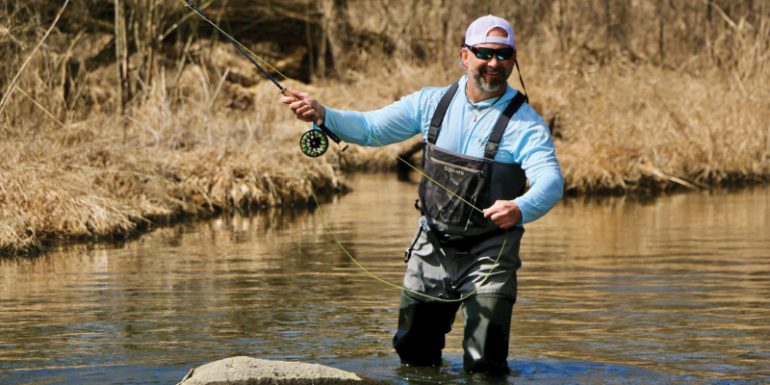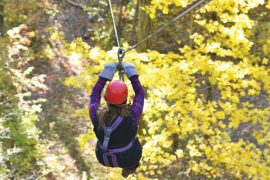By Maura Keller | Photo by Liz Hoffman
In the now classic 1992 film “A River Runs Through It,” a young Brad Pitt stands up to his waist amidst the cascading water of the flowing river rapids, effortlessly fly fishing. For many people, the movie was their introduction to elegant serenity of the sport of fly fishing, which today continues to attract anglers who are drawn to a fishing alternative. However, while the Lake Geneva area has long been a popular destination for traditional lake fishing, the area’s rivers and streams remained less well-known, despite the fact that when it comes to fly fishing, the region is an angler’s variety pack. Here you can catch Northern pike, panfish, musky, salmon, smallmouth and largemouth bass, and perch in the numerous inland streams and rivers dotting the region.
George Kaider, owner of In the Flow Fly Fishing Guide Service in Lake Geneva, wants to spread the word about the area’s fly fishing opportunities. He has been a fisherman since he was a young boy, when his grandmother taught him how to fish in a pond behind her home in Florida, but it wasn’t until many years later that he discovered the joys of fly fishing. “When I was in college, my mother-in-law lived in Cross Plains, just northwest of Madison, near a famous trout stream called Black Earth Creek,” Kaider says. “While I was out there casting little spinners, I saw some fly fishermen casting, and immediately said to myself, ‘I want to do that.’ It looked so graceful and beautiful to watch — I was immediately intrigued.” Kaider says he bought a cheap fly rod, a reel and some basic gear, and attempted to teach himself how to fly fish. It did not go well.
“I could not execute a cast, lost most of my flies, and my leader was tangled in a mess,” he says with a smile. “I put down the fly rod and returned to traditional fishing due to the frustration.” Giving it a second chance a few years later, Kaider took up the fly fishing rod again and learned everything he could about the sport, and from that moment forward, he was hooked. Today, as a fly fishing guide throughout the Lake Geneva area, he assists other fly fishing aspirants and shares his vast knowledge of how to catch the best fish.
Along his journey to become a fly fishing guide, Kaider says the sport has taken him to some of the most beautiful places on earth and helped him to meet incredible people. It has been a powerful force for personal growth. “Tying flies, targeting different species, the constant movement and exploring new rivers and streams,” Kaider says. “I keep learning so much about the sport that is intriguing. There is always something new to learn, but the repetitive motion of casting while alone on a river is a spiritual experience for me.”
As Kaider explains, most fly fishing is done on rivers and streams, but fly fishing can be enjoyed on lakes as well. The difference between fly fishing and traditional fishing is that the fly fisherman has total control over the fly, the cast and the retrieve. “In conventional fishing, the lure and reel do all the work,” he explains. “But in fly fishing, the angler ties the fly, builds the leaders and has to learn many different casts and retrieves.”
GATHERING THE RIGHT SUPPLIES
As Kaider makes clear, when it comes to fly fishing, the equipment is an extremely important part of the process. To get started fly fishing, an angler will need a fly rod, fly reel, fly line, leader and a fly. However, part of the challenge is that the size of the fly rod needs to match the reel and the fly line, so different rod setups are needed to target different species.
“There are many different types of fly rods that have different actions, so it’s important to match the rod to your casting style,” Kaider says. “It’s not complicated, but it’s important to have a good understanding of the right gear for the application.” And to stay dry and warm, Kaider recommends waders and wader boots for all but the warmest fishing days.
With fly fishing, the tying of the flies themselves is a key component for many anglers. Kaider says he always wanted to learn to tie flies but initially stayed away from it because he was just too intimidated by the process. However, he eventually decided to jump head-first into fly tying. “I bought books and DVDs and spent countless hours watching experts on YouTube,” he explains. “I watched the constructionofeverythingfromtinydry flies and nymphs to massive streamers, and everything in between. I wanted to learn it all — I began by just watching and reading.”
The first fly Kaider tied was a type known as a black wooly bugger, which is a common fly for beginners since it uses many basic principles of tying. “It’s fascinating for me to think that a hook, thread and feathers are all independent materials from each other, however, when combined with skill and imagination, a fly develops right in front of my eyes,” Kaider says. “The art of fly tying is unlimited, and that, too, allows my imagination to create anything I think a fish will eat. The thought of creating an imitation of a bug, crayfish or a baitfish that will trick a fish into eating it keeps me coming back… this is the art of fly tying.”
LOCATION, LOCATION, LOCATION
While the rapid-flowing rivers of the western United States provide some of the best fly-fishing opportunities, Kaider says the Lake Geneva region and Wisconsin in general offer plenty of spots for a good catch. The best locations depend on what type of fish you are hoping to catch. Most people only associate fly fishing with trout and mountain streams, but almost any fish can be snared by a fly rod.
Kaider personally fishes and guides for a variety of species depending on the river, time of year and the fly-fishing technique he wants to use. During the summer months, most of his time is spent fishing for smallmouth bass and pike. In the fall, he turns his action toward musky, salmon and brown trout. During the winter, he primarily targets pike since they are one of the few species still actively eating at that time. In March and April, Kaider targets steelhead in the Lake Michigan tributaries and also trout in the Driftless Region of southwestern Wisconsin.
“Water temperature, barometric pressure and water levels can have a huge impact on fishing so I usually don’t know what river I will be guiding on until a few days before,” Kaider says. “I spend a lot of time studying the weather and water flows, and researching new rivers. It’s a fun and necessary part of having a guide business.”
How to Prepare Freshly Caught Fish
While Kaider rarely keeps fish for consumption, preferring to practice catch-and-release to help maintain a productive fishery, he says that he will occasionally keep trout or salmon to serve on the dinner table. His favorite recipe is very simple: trout fried in a skillet with butter and garlic, stuffed with tomato and fresh spinach.
For those wanting to make their own fish fry, the Wisconsin Department of Natural Resources offers their “Famous Triple Dip Fish Fry” recipe.
Ingredients:
- 1 pound fish fillets
- 1 cup flour
- 1/4 teaspoon ground pepper
- 1/4 teaspoon paprika
- 1/4 teaspoon salt
- 1 egg
- 1/8 cup water
- 1 to 1 1/2 cups bread or cracker crumbs
- Cooking oil
Instructions:
- Pat fish dry with paper towels and set aside.
- In a shallow dish, mix flour, pepper, paprika and salt.
- In another shallow dish, beat egg together with water to make an egg wash.
- In a third shallow dish, place the crushed crumbs of your choice.
- Pick up a fillet and dip it in the first bowl until coated with flour. Next dip the fillet in the egg wash, then transfer it to the third dish and pat the crumbs evenly over the entire fish. Do this for each fillet, separating them with aluminum foil on a plate.
- There are two cooking options.
- To fry: Heat 1/4-inch of cooking oil in a heavy skillet. When a pinch of flour sizzles in the pan, it’s hot enough for the fish. Cook a few fillets at a time until the fish are brown and crispy.
- To bake: Coat a pan with cooking oil and place it in the oven, empty. Heat oven to 450°F. Place fillets on the heated pan and cook about 6 to 7 minutes on each side, until flaky and crispy.





